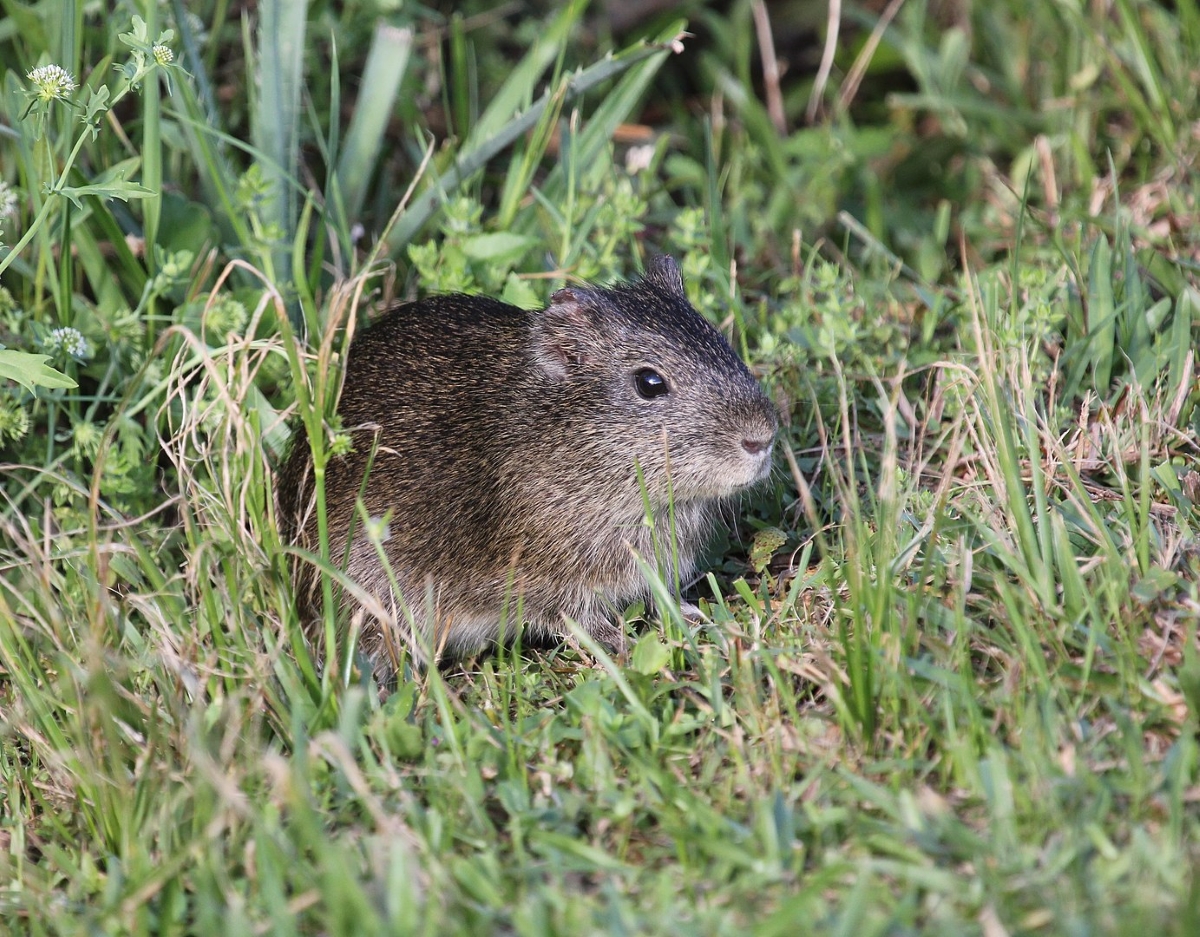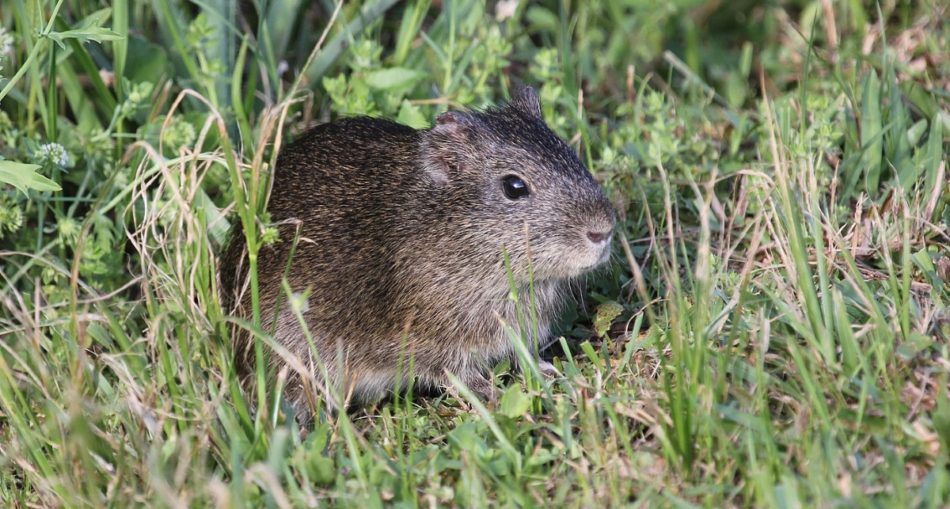The Brazilian Guinea Pig is a diurnal rodent indigenous to the tropical grasslands of South America. The scientific name of the Brazilian Guinea Pig is Cavia aperea. Cavia aperea is one of five (5) nondomesticated members of the genus shiny guinea pig (Cavia fulgida), greater guinea pig (Cavia manga), montane guinea pig (Cavia tschudii) and the Moleques do Sul guinea pig (Cavia intermedia). It is believed that the domesticated guinea pig originated from one of the wild Brazilian, montane or shiny Guinea Pig. The Brazilian Guinea Pig is native to countries like Guyana, Argentina, Brazil, Bolivia, Colombia, Ecuador, Paraguay, Uruguay and Venezuela.

The Brazilian Guinea Pig – Photo By Leyo – Self-photographed, CC BY-SA 3.0 ch, https://commons.wikimedia.org/w/index.php?curid=21417167
Features Of The Brazilian Guinea Pig
Colour – Fur is usually dark olive-brown combined with brown and black with pale grey or yellowish-grey underparts. However, some Brazilian Guinea Pigs are red and black.
Body Structure – Brazilian Guinea Pigs have stout bodies and relatively short tails about two point four (2.4) mm. Their forefeet comprise of four (4) toes while their hind feet have three (3) toes.
Weight & Length – The Brazilian Guinea Pig has an average length of two hundred and seventy-four (274) mm, However, this varies from one hundred ninety-six to three hundred and twenty (196-320) mm, with the males being larger than their female counterparts. Their weight is anywhere between five hundred and twenty to seven hundred and ninety-five (520-795) g.
Interesting Tip
- The dental formula of the Brazilian Guinea Pig is 1/1, 0/0, 1/1, 3/3 and they do not have canines.
- The darkest part of their body is along their spinal ridge but lightens as it reaches the lower side of the rodent.
Scientific Name Of The Brazilian Guinea Pig
- Kingdom: Animalia
- Phylum: Chordata
- Class: Mammalia
- Order: Rodentia
- Family: Caviidae
- Genus: Cavia
- Species: C. aperea
Habitat Of The Brazilian Guinea Pig
The Brazilian Guinea Pig lives in the neotropical region, with the exception of tropical rain forests. The rodents inhabit savannahs and grasslands at altitudes anywhere between four hundred and three thousand (400-3000) m above sea level. However, they can also be found in the highlands of the Andes mountain range. They prefer dense ground vegetation in which they create a complex series of pathways.
Diet Of The Brazilian Guinea Pig
Brazilian Guinea Pigs are herbivores who predominantly feed on true grasses (Poaceae) but will eat other grass. They eat leaves, stems, seeds, nuts, grains and sometimes tubers or roots.
Behaviour Of The Brazilian Guinea Pig
The Brazilian guinea Pig is a social creature, who tends to live in small familial groups, made up of one male, one to two (1-2) females and their offsprings. Several dozen groups of the Brazilian Guinea Pig are able to live in adjacent territories. The rodents graze in small groups so they can detect potential predators easily. They communicate by auditory signals, screams and squeals and scent marks.
Interesting Tip
- The male Brazilian Guinean Pig may not mark their territories but will mark their mates.
- They have two distinct scent glands, a sebaceous gland located on their dorsal part of their bodies and the perineal gland, located near the anus.
Reproduction Of The Brazilian Guinea Pig
These rodents are polygynous meaning that one male can mate with a number of other females, typically not more than two (2). Breeding occurs all year round and a female can produce as much as five (5) litters per year. The Brazilian Guinea Pigs can reproduce at twenty-eight (28)days old. Brazilian Guinea Pigs have a gestation period of sixty-two (62) days after which the female gives birth to about two (2) pup per litter. At birth, the Brazilian Guinea Pigs’ eyes are open and their bodies are completely covered in fur, able to move simply hours after. They are weaned at about twenty-five days old but they are able to eat solid food at three (3) days old. Soon after maturing, the juveniles move on.
Five Facts About The Brazilian Guinea Pig
- The meat of Guinea Pigs is called cuy and is a prized delicacy.
- In captivity, the Brazilian Guinea Pig lives up to ten (10) years but can only survive up to eight (8) years in the wilderness
- While the Brazilian Guinea Pig is primarily diurnal or active in the day, it is also crepuscular meaning is also active primarily during twilight.
- The male Brazilian Guinea Pig will not defend territorial boundaries but will defend their mates from rivals. Also, for a short period after birth, the males will also protect females and pups but are generally uninvested in rearing.
- Their constant growing teeth are maintained by persistent gnawing.
The Brazilian Guinea Pig In Guyana
The Brazilian Guinea Pig is a medium-sized rodent and believed to be the wild relatives of the domestic guinea pig. They are usually social creatures living in small groups in the savannahs and grasslands of the South America continent.
Article References
- https://animaldiversity.org/accounts/Cavia_aperea/
- https://en.wikipedia.org/wiki/Brazilian_guinea_pig
- https://www.britannica.com/animal/Brazilian-guinea-pig
- https://www.britannica.com/animal/guinea-pig#ref756438
- https://www.banhamzoo.co.uk/animals/brazilian-guinea-pig-2/
Discover more from Things Guyana
Subscribe to get the latest posts sent to your email.







